 |
| Slaving over a hot keyboard, working for Sam Evangelidis (Australia, 2013) |
Saturday, October 26, 2013
Ten Cents a Ticket in My Double Bed Blanket (a New Music Video!)
Who would have thought it: me the wannabe writer, the wordsmith, I've gone and done something completely left-field, and become a music video producer! It was never something I imagined I would be good at, or even able to attempt... but for the past couple of weeks, I have not only been making videos, but getting paid for it! Exploiting skills honed over many years of manipulating images on Gimp or Online Image Editor, and expanding my savvy to encompass Windows MovieMaker, and YouTube. I know I am not going to win any awards for these clips, or infect the world with a virus, much as my sponsor might hope so. I'm certainly not going to get rich, and neither, probably, will he. I don't really care, and I've never really gone for the viral success thing anyway. Ever since I hit "rock bottom" last month I have been looking for any excuse to escape, and clamber goat-style back up the slope which by definition must rise (since I am at rock bottom), somewhere around me, if only I can find it. One day last month, sunk deep in my funk, stranded on my desert island, I received a message from one Sam Evangelidis, an associate of Garnet Mae, asking me if I could help him out. Sam was the famous milk truck investor for Meat Pie, if my memory serves me right, and lives in the Blue Mountains west of Sydney. He wanted me to produce some videos for his songs. He has a lot of them, and most of them are pretty good.
This joyride here, is the third video I have made for Sam. Called Ten Cents a Ticket in My Double Bed Blanket, this is hip hop with a suburban Sydney twist. Not quite MC Kerser, but it's mean enough. Samples and a bassline which sound like something on a Drum&Bass track. Drums and bass and a delicious diva... what could be better than that? What could be better than the fact that I am involved in it?
Thursday, August 8, 2013
The 7 Hindrances, and the 20% Accomplishment Rule
I might dream of conquering the world, but Reality reminds me that we rarely achieve more than just a fraction of our goals. How much of a fraction is a troubling question -- from my experience it could be a quarter, it might be just a fifth. In the summer of 2006 I was enthralled by a Utopian hope: despite my deepening debt I sincerely believed that medical trials could save me, and manifest for me the jetsetter life I was craving for. Not only would I be able to kick back in Kagoshima (鹿児島) with the cool kids, living it large, but I could use the payments from each trial to party around the planet. Of course, it never worked out that way, and Telephone English (TE) became my actual saviour. Here was evidence of the 25% Accomplishment Rule in action... I didn't qualify as a lab rat, but I was delivered from poverty just in the nick of time, and pumped full of cash. Some of my goal was realized, to be sure, but not all of it, and that was the thing. There were a few Hindrances standing in the way: love was one of them; health, another...
When I started teaching at TE I had big plans to take two months off every year and fly off to Thailand, Iceland, Australia and destinations even further afield, such as Jamaica. In the end I got stuck at my first port of call in Ho Chi Minh City, Vietnam, and most of my funds were squandered there, entranced as I was by tropical romance. I did score a short stopover in Bangkok and two trips to Australia, but much as I would have liked it, I never reached Iceland. Jamaica was completely out of the question. So, my original plan was only partly achieved (25% achieved, perhaps, or only 20%, I haven't figured out the exact percentage!) I had a lot of fun nonetheless and Nga became a cause in herself, a Baudrillardian seduction... she derailed my plans, blew my budget, and in the end I accomplished only a quarter of my aim, or even less than that (how much? how much?) In 2011 I quit TE and abandoned Japan and returned back to Australia, where I the One World Orbit was conceived. Imagining that Google Adsense could free me from employment entirely, I researched the cost of living in Indochina, which various guidebooks suggested was the cheapest region on Earth. I intended to spend three years jaunting around Cambodia, Laos, Vietnam, northern Thailand, and southern China, mucking about on the Mighty Mekong (the Great River, the River of Nine Dragons, ແມ່ນ້ຳຂອງ, 湄公河, etc, etc.) I called it the Indochinese Triennium. It would have been perfect, but my Adsense collapsed, and then I lost Indochina. All I have left is China, which is one-half of Indochina, semantically speaking, but pragmatically much less than that. It is just one-fifth of my original plan, or even a sixth. Furthermore, when I go to China I will have to work to survive, at some school like Wall Street. It sucks but it is better than nothing, and at least I will be back on the road. I can always visit Cambodia in my holidays, and plenty of other nearby nations! That is, if the Seven Hindrances give their assent.
When I started teaching at TE I had big plans to take two months off every year and fly off to Thailand, Iceland, Australia and destinations even further afield, such as Jamaica. In the end I got stuck at my first port of call in Ho Chi Minh City, Vietnam, and most of my funds were squandered there, entranced as I was by tropical romance. I did score a short stopover in Bangkok and two trips to Australia, but much as I would have liked it, I never reached Iceland. Jamaica was completely out of the question. So, my original plan was only partly achieved (25% achieved, perhaps, or only 20%, I haven't figured out the exact percentage!) I had a lot of fun nonetheless and Nga became a cause in herself, a Baudrillardian seduction... she derailed my plans, blew my budget, and in the end I accomplished only a quarter of my aim, or even less than that (how much? how much?) In 2011 I quit TE and abandoned Japan and returned back to Australia, where I the One World Orbit was conceived. Imagining that Google Adsense could free me from employment entirely, I researched the cost of living in Indochina, which various guidebooks suggested was the cheapest region on Earth. I intended to spend three years jaunting around Cambodia, Laos, Vietnam, northern Thailand, and southern China, mucking about on the Mighty Mekong (the Great River, the River of Nine Dragons, ແມ່ນ້ຳຂອງ, 湄公河, etc, etc.) I called it the Indochinese Triennium. It would have been perfect, but my Adsense collapsed, and then I lost Indochina. All I have left is China, which is one-half of Indochina, semantically speaking, but pragmatically much less than that. It is just one-fifth of my original plan, or even a sixth. Furthermore, when I go to China I will have to work to survive, at some school like Wall Street. It sucks but it is better than nothing, and at least I will be back on the road. I can always visit Cambodia in my holidays, and plenty of other nearby nations! That is, if the Seven Hindrances give their assent.
Sunday, July 14, 2013
Thursday, June 13, 2013
Privacy Policy
Privacy Policy for VAGABONDIC.
If you require any more information or have any questions about our privacy policy, please feel free to contact us by email at coderot@gmail.com.
At Vagabondic (vagabondic.blogspot.com), the privacy of our visitors is of extreme importance to us. This privacy policy document outlines the types of personal information is received and collected by Vagabondic and how it is used.
Log Files
Like many other Web sites, Vagabondic makes use of log files. The information inside the log files includes internet protocol (IP) addresses, type of browser, Internet Service Provider (ISP), date/time stamp, referring/exit pages, and number of clicks to analyze trends, administer the site, track user's movement around the site, and gather demographic information. IP addresses, and other such information are not linked to any information that is personally identifiable.
Cookies and Web Beacons
Vagabondic uses cookies to store information about visitors preferences, record user-specific information on which pages the user accesses or visits, customize Web page content based on visitors browser type or other information that the visitor sends via their browser.
DoubleClick DART Cookie
.:: Google's use of the DART cookie enables it to serve ads to your users based on their visit to Vagabondic and other sites on the Internet.
.:: Users may opt out of the use of the DART cookie by visiting the Google ad and content network privacy policy at the following URL - http://www.google.com/policies/technologies/ads/.
Some of our advertising partners may use cookies and web beacons on our site. Our advertising partners include .......
Amazon
Chitika
Google Adsense
These third-party ad servers or ad networks use technology to the advertisements and links that appear on Vagabondic sent directly to your browsers. They automatically receive your IP address when this occurs. Other technologies (such as cookies, JavaScript, or Web Beacons) may also be used by the third-party ad networks to measure the effectiveness of their advertisements and/or to personalize the advertising content that you see.
Vagabondic has no access to or control over these cookies that are used by third-party advertisers.
You should consult the respective privacy policies of these third-party ad servers for more detailed information on their practices as well as for instructions about how to opt-out of certain practices.
Vagabondic's privacy policy does not apply to, and we cannot control the activities of, such other advertisers or web sites.
If you wish to disable cookies, you may do so through your individual browser options. More detailed information about cookie management with specific web browsers can be found at the browsers' respective websites.
Robert Sullivan, Webmaster, June 13 2013.
Wednesday, May 29, 2013
Indians in Japan
When I lived in Japan I used to see Indians almost every day, just about every day. They were practically everywhere, at least in Tokyo and its surrounds, where I spent most of my time: teaching English, running supermarkets, working in IT; you'd see couples or whole families strolling under parasols through wet Myoden (妙典) on the way to the recycled clothes store at Gyotoku (行徳), or jogging on the concrete banks of the Arakawa River (荒川) in Hirai (平井), or jostling along with the rest of human tide in Shinjuku (新宿) where Indian and Pakistani and Bangladeshi restaurants always did a good trade, and Indian food was popular, perennially. I probably noticed them more because I happened to live in Shinozaki in the Edogawa Ward of Tokyo, which was (and still is) renowned for being one of the centers of the Indian diaspora in Japan. There was an Indian kindergarten/preschool/elementary school/high school just down the road from my old place, near Mizue Station in South Shinozaki. There were plenty of Indians on the train, the Toei Shinjuku Line train. For some reason the Indians tended to congregate in the first carriage, it had become a local tradition. According to statistics there were 22,000 Indians living in Japan in 2010, but there actually seemed to be a lot more. That might because as a foreigner I tended to notice other foreigners easily, and Indians stuck out from the crowd just as much as I did.
Being a nomad myself, I am always interested to meet fellow wayfarers in strange parts of the world, and understand what motivated them to leave the safety and security of home. I also have an interest in ethnic enclaves in general, like the eccentric Ethiopian congregation on the roof of the Church of the Holy Sepulchre in Jerusalem, or the Icelandic/Scandinavian towns on the North American plains. About five years ago (late 2007) I was invited to dinner by Umesh my old Nepali friend in Koenji in west Tokyo, and in the process, I got a glimpse of just how the subcontinental community in Japan lives. Like my own neighborhood in Shinozaki, Koenji has become a magnet in recent years to guest workers and opportunists from the subcontinent: Umesh said his ageing apartment building was owned by a Pakistani. His next-door neighbor was an Indian, and the cold concrete passageway outside the house was more than tinged with the scent of curry. What proved interesting to me, as I dined with Umesh and his wife, was the education into how modern Diasporics use new technology to connect with each other and entertain themselves in their adopted countries. In short: I never used to be much of an Indian movie fan, but if I spend more time at Umesh's house in the concrete heights of Koenji, I will become one.
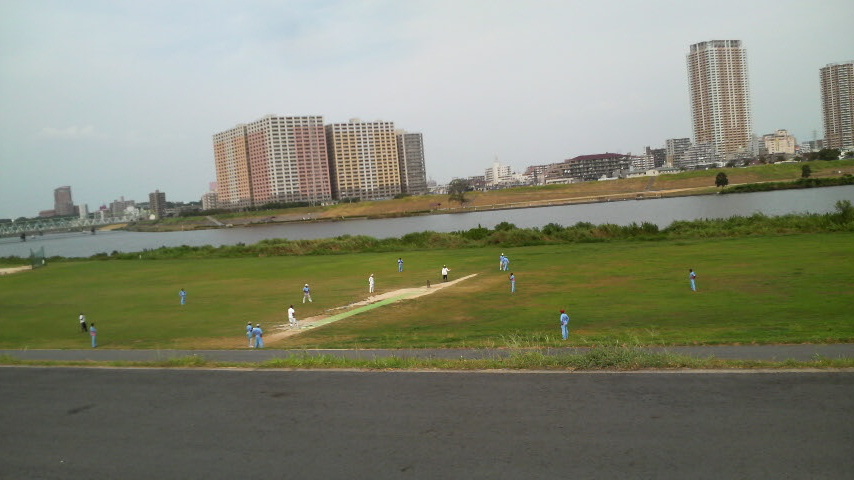 |
| Indian cricket game on the bank of the Edogawa River, facing Ichikawa City, surrounded by baseball fields. |
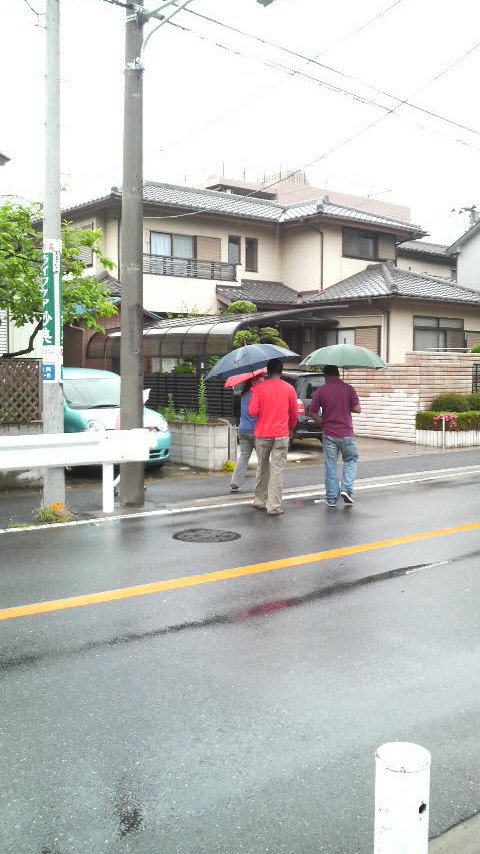 |
| Myoden, a quiet suburban region near Urayasu in Chiba Prefecture, boasts a large Indian community, as well as an Indian kindergarten. |
Roughly two months after, in February 2008, I returned to Koenji to see Umesh -- it was a truly brutal Sunday afternoon, wind blowing a gale and cold as hell. Things looked warmer in Koenji's PAL Arcade however, with curry shops all over the place, and the atmosphere positively screaming Little India, as the Japanese "king of subculture" Jyun Miura once observed. Umesh made some steaming food and we cracked open a few bottles of beer, ice cold of course. It was cricket season down Under, and Umesh was following the action in the India vs Australia One Day game at the SCG -- not on TV or radio or online TV, but rather watching a text feed updated delivery by delivery, over by over, over the computer. It was like watching a scoreboard -- changes in the numbers denoted action, a leg-bye here, a boundary there. About as far from high fidelity as you can imagine, but at least it was live (real time), and it was in its own way, absolutely riveting (admittedly, it was an unusually exciting match.) Umesh was barracking for the Indians, and I was barracking for the Aussies, and we were drinking big bottles of Asahi beer, and downing a range of Nepali treats. There was no picture and there was no sound, but we had the power of imagination (the world's first Virtual Reality.) In my mind's eye I see it all: the Indians rallying valiantly, in the closing overs, to reach Australia's 7/317 (they were eventually dismissed for 299.)
We had no audio, but you didn't need ears to hear the taunts which must have belched from the stands at the Sydney Cricket Ground every time an Indian tail-enders put bat on ball, and darted up to the other end of the wicket. You could feel the tension in the air, as the old cliche goes, even this far away, in wintry Japan... the atmosphere was boiling over. At home in Australia, I could well imagine my Dad cursing at the TV and perhaps even launching the remote-con at the screen, once it dawned on him that India might have a chance of winning. But then Sharma was bowled out by Lee, and everything was golden again, Down Under. Rapturous cheers, and grinning commentators delivering their post-mortems. It was a vivid moment which proved to me that sometimes imagination outclasses technology; and the nearest memory it evoked, was listening to the action at Lords on shortwave radio, when I was about eight-years-old and living on the NSW Central Coast. Those were the days when books had better special effects, than the Hollywood recreations of them (I am thinking in particular of JRR Tolkien's The Lord of the Rings, or Baz Lurhmann's The Great Gatsby). The following night, at my singing job in Shinjuku, I related the story to my Kiwi coworker D. "It is a pity there is nowhere on the Internet you can watch the cricket live," I remarked. "But there is," D. said. "Why don't you try Sopcast? There is some Indian guy running it, feeding cable TV live on to the Net."
 |
| PAL Arcade in Koenji, the heart of Tokyo's "Little India". |
Saturday, May 18, 2013
Vintage Shibuya
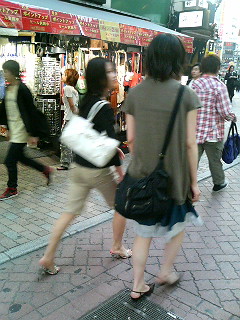 One of the first places I visited in Japan was Shibuya (渋谷), the jubilant youth fashion quarter south of Shinjuku, on the prosperous west side of Tokyo. The date was November 11 2000, my first ever morning in Japan! The sun was shining, the crows were cawing: it was textbook Tokyo to a treat. Unfortunately, my baggage had been lost in transit, and was sitting on a carousel at the airport in Singapore. I was dressed only in my Australian jeans and a T-shirt, and the cold Japanese winter was coming on. I needed to buy a winter coat -- and cheaply! Fortunately, Shibuya saved me. That's the great thing about it, it is a Mecca for recycled clothing. I never expected it would be like this, until I took my first stroll through the narrow winding streets here, looking for a place to stay. I thought Japanese hated old stuff, and were obsessed with the shiny and new. Certainly, the architecture accumulated around Shibuya's sprawling railway station seemed futuristic to a fault, that morning in November 2000: towering department stores, some adorned with colossal TV screens or posters of J-Pop stars, and ads for the latest Beatles anthology. That was the kind of Japan I was expecting and it was all there, in overload. Brand name department stores and bling, check. Fast, brightly colorful passenger trains whizzing by overhead, you bet. Hypermanic salespeople spruiking the crowds with their megaphones and cupped hands, sure. But second hand clothes stores? Who would have thought that? There were tonnes of them, especially on the road which links Shibuya to Yoyogi Park, which I trudged up looking for lodgings. I couldn't find anywhere to stay, but I shortly discovered a preloved jacket, in a bitching industrial style!
One of the first places I visited in Japan was Shibuya (渋谷), the jubilant youth fashion quarter south of Shinjuku, on the prosperous west side of Tokyo. The date was November 11 2000, my first ever morning in Japan! The sun was shining, the crows were cawing: it was textbook Tokyo to a treat. Unfortunately, my baggage had been lost in transit, and was sitting on a carousel at the airport in Singapore. I was dressed only in my Australian jeans and a T-shirt, and the cold Japanese winter was coming on. I needed to buy a winter coat -- and cheaply! Fortunately, Shibuya saved me. That's the great thing about it, it is a Mecca for recycled clothing. I never expected it would be like this, until I took my first stroll through the narrow winding streets here, looking for a place to stay. I thought Japanese hated old stuff, and were obsessed with the shiny and new. Certainly, the architecture accumulated around Shibuya's sprawling railway station seemed futuristic to a fault, that morning in November 2000: towering department stores, some adorned with colossal TV screens or posters of J-Pop stars, and ads for the latest Beatles anthology. That was the kind of Japan I was expecting and it was all there, in overload. Brand name department stores and bling, check. Fast, brightly colorful passenger trains whizzing by overhead, you bet. Hypermanic salespeople spruiking the crowds with their megaphones and cupped hands, sure. But second hand clothes stores? Who would have thought that? There were tonnes of them, especially on the road which links Shibuya to Yoyogi Park, which I trudged up looking for lodgings. I couldn't find anywhere to stay, but I shortly discovered a preloved jacket, in a bitching industrial style!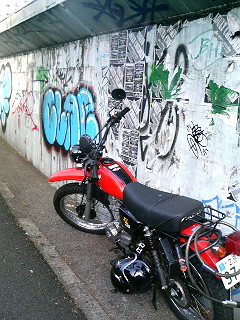 According to the must see website: "Shibuya leads Japan in popularity, constantly creating new culture in the worlds of fashion, food, and music. Fashion trends that start here always draw the attention of young people and they quickly spread throughout Tokyo and then the rest of the country. Sometime between the late 80's and early 90's, Shibuya started to attract public attention as a fashion town. Shibuya, subsequently became more entrenched as the definitive spot for Tokyo's youth. With the boom in brand awareness and the economic boost of the Bubble Economy, PARCO and Marui enjoyed several prosperous years in that era. After Shibuya reached its peak as a trend-setting neighborhood, the town quickly fell back during the economic strife of the late 90's. Though the unusual fashion and makeup among teenage girls captured public attention again during the late 90's, it was in vogue for a very short time."
According to the must see website: "Shibuya leads Japan in popularity, constantly creating new culture in the worlds of fashion, food, and music. Fashion trends that start here always draw the attention of young people and they quickly spread throughout Tokyo and then the rest of the country. Sometime between the late 80's and early 90's, Shibuya started to attract public attention as a fashion town. Shibuya, subsequently became more entrenched as the definitive spot for Tokyo's youth. With the boom in brand awareness and the economic boost of the Bubble Economy, PARCO and Marui enjoyed several prosperous years in that era. After Shibuya reached its peak as a trend-setting neighborhood, the town quickly fell back during the economic strife of the late 90's. Though the unusual fashion and makeup among teenage girls captured public attention again during the late 90's, it was in vogue for a very short time."However, while the economy has slumped, recycled fashions have risen to a new prominence. When funds run low, you turn to budget alternatives. And I believe this is one reason why Japan today is caught in a recycled clothing epidemic. Japan is turning to cheaper alternatives -- this is a good thing, a vagabondist thing. To me, nothing seems so vagabondist as the recycling of clothes and other essential items. It is the ultimate in vagabondism, and Japan is now patently a vagabondist country -- I realised that as soon as I stepped off the plane. I was expecting it to be a Bubble economy, but thankfully it turned out to be postBubble. It was (and still is) a glimpse of life after the Baudrillardian implosion, for those Westerners saddled with their fantasies of endless growth. Young people in Japan understand that while the conveyor belts of production are now dragging to a halt, there are nonetheless vast mountains of goods lying around all over the world, some of them in their original wrappers, waiting to be (un/dis)covered. Just don't call these gems "second hand", or even recycled... they're vintage! Japanese might be budget conscious, but they still have class. Even when they're grungy, Japanese are styling!
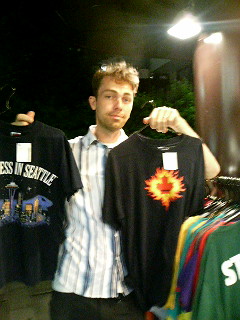
For the next 10 years, I used to go shopping in Shibuya a lot. Eventually I got sick of it, and started looking for fresh pastures, out in the suburbs where tourists rarely tread. When foreign friends and relatives came to visit, however, they always insisted on meeting in Shibuya, and seeing that globally renowned Tokyo street style. I made sure to show them some of the recycled clothes stores in the neighborhood too, and my guests were always impressed.
There are flea markets in the Shibuya as well, especially around Yoyogi Park (opposite the NHK headquarters) on weekends, and they are usually popular. The International Herald Tribune reports:
There are two choices when it comes to buying used clothes in Tokyo: flea markets or clothing shops. Make that three choices if you count the street stalls that crop up on sunny days.
A visit to the Sunday flea market on the roof of the Tokyu Store, across from the East Exit of Shibuya Station, gives a glimpse into the future of clothes recycling in Japan. Most of the buyers and sellers are school kids in their early teens, who pour out of the rooftop elevator at 10 A.M. lugging big sacks of clothes to sell to each other. The limited roof space fills up quickly with shoppers sifting through clothes, shoes, a few electronic goods and the occasional box of used CDs or tapes.
By 11 A.M. the place is crammed, but you can usually decide whether a vendor's clothes are worth working your way toward by looking at what he or she is wearing. If the vendor goes for the massive-street-pants-and-oversized-shirt look, and you don't, try another direction.
Prices vary, but they tend to be low. Jeans that sell for 7,000 yen ($84) or more at the established Shibuya department stores can be found in nearly the same condition for 1,000 yen or less. T-shirts are another popular item that can be bought for around 500 yen. Point out imaginary flaws and demand a discount if you want: Bargaining is considered all part of the fun.That's an insight into flea markets, but what about the vintage stores? Here is a snapshot of what existed in Shibuya in the mid 2000s (sorry if some of this information is a bit old!):
Cat Street, 6-14-7 Jingumae, Shibuya Ward, Tokyo.
Phone: (03) 5464 5580.
This story was lifted from Tokyo's well known and even more well read Metropolis magazine:
The craze for vintage clothing has been hitting some fashion retailers pretty hard, especially those whose business is street casual wear. Few brands are as prized as adidas when it comes to vintage, and the guys at head office have come up with a scheme to cash in on the cachet of the company's illustrious history: adidas Originals. Opened on Cat Street last month, the store is laid out much like a flea market with low trestle tables and haphazard stacks of cardboard boxes. The stock consists chiefly of remakes of classic adidas items from 1972-1996, allowing shoppers to get the retro look without having to traipse around swap meets or trawl through vintage stores. You may need to wear in the 83-C training top and 1976 Stan Smiths yourself, but at least the smells and stains will be your own. Some newly designed items on offer include the affordable Levi's collaboration denim sneakers and not-so-affordable Swarovski collaboration, a rhinestone-encrusted fantasy shoe available only in this store.The shack is open from 11am-8pm daily.
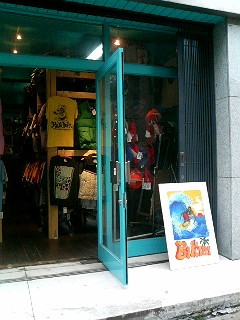 Bikini Surfboard: 渋谷区神宮前.
Bikini Surfboard: 渋谷区神宮前.Jingumae, Shibuya Ward, Tokyo.
Phone: (03) 3409-5017.
On the way to the Olympic Stadium and Yoyogi Park, if you are heading from Shibuya. Despite what the name implies, they don't sell surfboards here, but rather recycled surfwear like T-shirts and sh!t. Billabong and the House of Town & Country and all that jazz. I didn't see any bikinis inside either, so don't go looking for them. Placing your trust in Japanese-English names and signs will always disappoint you. I can almost imagine when the guys who opened this store were trying to think of a name, they decided just to slam together all the surf-related English words that they knew. "What surf words do we know? -- bikini... surfboard... hey, let's call the shop Bikini Surfboard!" It would be like if a bunch of Californian guys who spoke no Japanese decided to open a sushi restaurant -- what would they call it? "Sayonara Samurai" or something like that? Or maybe just "Sayonara Sucker"!
There are of course surf-inspired and Hawaiian stores all over Japan, but this one has a strictly recycled and vintage theme.
Open 11am to 8pm.
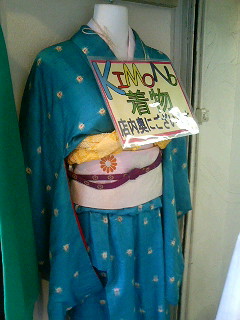 Chicago: 渋谷区神宮前6-31-21.
Chicago: 渋谷区神宮前6-31-21.6-31-21 Jingumae, Shibuya Ward, Tokyo.
Phone: (03) 3409 5017. Web: http://www.chicago.co.jp/.
Variety of vintage goods here: T-shirts, training gear, jeans, hats, coats, kimono, haori, modern clothing made from kimono, much more. Has several stores, mostly in Tokyo. At the Harajuku branch, you can even buy a used kimono!
The complete store list is as follows:
Omotesando Store/Tokyo: 6-31-21 Jingumae Shibuya Tokyo. Phone (03) 3409 5017.
Jingumae Store/Tokyo: 4-26-26 Jingumae Shibuya Tokyo. Phone (03) 5414 5107.
Shimokitazawa Store/Tokyo: 5-32-5 Daizawa Setagaya Tokyo. Phone (03) 3419 2890.
Sapporo Store: 1-3 Nishi Minami 1 Jyou Chuou Sapporo Hokkaido. Phone (011) 219 2202.
Fukuoka Store: 1-15-35 Daimyo Chuou Fukuoka. Phone (092) 739 0165.
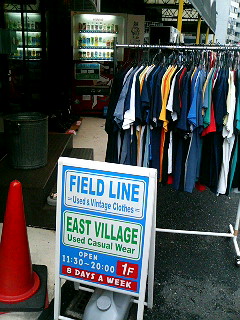 East Village/Field Line: 渋谷区神宮前6-19-16第3宇都宮ビル1F .
East Village/Field Line: 渋谷区神宮前6-19-16第3宇都宮ビル1F .1st Floor Number 3 Utsunomiya Building, 6-19-16 Jingumae, Shibuya Ward, Tokyo.
Phone: (03) 3486 6716.
低価格、豊富な品揃え、高品質の古着を展開するイースト ヴィレッジ。アメカジ古着を中心としたラインナップは、ストリートの中でハズせないものばかり。ウェアだけでなく、ブーツなどフットウェアから、小物まで幅広く取り扱っている。ヴィンテージを中心とした姉妹店フィールドラインも併設おり、ともにタウンスポットが経営している。
Last time I waltzed past there was a rack of shirts out the front selling for just 100 Yen... but maybe that was because it was an end of summer sale.
Up the road from East Village you can find Mesa, another select used clothing, which boasts badges... tonnes of them. Also plenty of shoes and French hip-hop stuff on the soundsystem, ultracool Japanese staff.
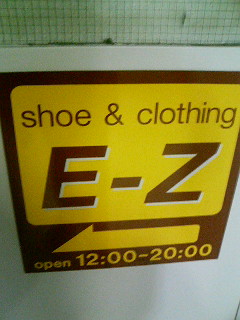 E-Z shoe & clothing: 渋谷区神宮前1-12-16和光ビル2AF.
E-Z shoe & clothing: 渋谷区神宮前1-12-16和光ビル2AF.2A Floor Wakkou Building, Jingumae, Shibuya Ward.
Phone: (03) 3780 0494.
A small, non-descript shop on the second floor of a building on the big road linking Shibuya and Harajuku, E-Z is packed with West Coast, recycled clothes -- basketball shirts and faded jeans, etc. To be honest this is one of my fave haunts in the Jinguumae area, and it is situated not far from Tower Records, one of the regional landmarks. Plenty of dead stock shoes with an Adidas look, including live actual Adidases. There are rare trainers from countries that don’t even exist any more, such as Yugoslavia and West Germany. Expect to pay between 20,000 Yen and 100,000 Yen for a pair of shoes. Clothes much cheaper... say 2000 Yen to 10,000 Yen for Levis from the 70s or a Tshirt of Bert & Ernie, or something from the Hawaian school of thought.
E-Z shoe & clothing is open from 12noon to 8pm daily.
Located in the basement floor of the same building is Tom’s Shop Usa 古着, which is described later in this article.
 Flamingo Saloon: 渋谷区神南.
Flamingo Saloon: 渋谷区神南.Jingumae, Shibuya Ward, Tokyo.
There is no sign on this store and the last time I visited, only a small piece of paper stuck to the door acknowledged its name: Flamingo Saloon. Then again, it might be called Pink Flamingo,I am not quite sure. At the very least there are two stores connected to each other (same owner perhaps, part of a chain) -- Pink Flamingo and Flamingo Saloon -- and you can find one of them in Shibuya, along the road at Jinguumae from Shibuya to Harajuku. This is basically another Shibuya style vintage clothes store with a street front. Phone is (03) 3477 7376 for the Flamingo Saloon and (03) 5489 4440 for the Pink Flamingo.
By the way, if you are interested in the world of Japanese city fashion, you should click this link -- it's an online Japanese fashion magazine, and it contains a list of clothes stores in Tokyo. They have an article inside called People Like A Used Clothing, with a model shot on location in such picturesque locations as Yoyogi Park.
 John's Clothing: 渋谷区神南1-11-5 ダイネス壱番館1F.
John's Clothing: 渋谷区神南1-11-5 ダイネス壱番館1F.1st Floor Dainesu Ichiban Jinankan, 1-11-5 Shibuya Ward, Tokyo.
Phone: (03) 3464 7705.
In the same building as another classic clothes store celebrating the spirit of California, Santa Monica, and adjacent to the wellknown guitar shop, Acoustic Design. This looks like a funky little number, but it is one of only many recycled/classic clothes stores in this part of town. Why do they call it John's Clothing? I am sure that this being Japan, the owner's name is probably something like Hiroshi or Koji or something like that. Anything but John. Perhaps they called this shop "John's Clothing" because John is the stereotypical name of the Westerner -- the Anglo-American-Australian who would normally be wearing these kinds of clothes. Nonetheless, the shop is cool, so you better check it out.
More Budget ESP: 東京都渋谷区神南1-9-2Oビル1F.
1st floor 0 Building, 1-9-2 Jinnan, Shibuya Ward, Tokyo.
Phone: (03) 3461 5055.
 You can find a lot of neat stuff in Shibuya... there is a whole hilly hiphop district and a big mall devoted solely to Harley Davidson apparel. The classic clothes district of Shibuya is not half as glamorous as the hiphop district, but perhaps that is in keeping with the laidback attitudes of the genre. In the middle of the district I found a store called More Budget ESP -- whether it is still there with the same name when you visit is an open question. Interestingly, More Budget is not really a classic clothes shop at all... but rather a hiphop/reggae influenced boutique. If like me you like reggae you will also like this shop. There are plenty of fliers on display giving you a good introduction to the Japanese reggae scene. For example I picked up a leaflet advertising a Reggae Dancehall night called Rocker's Paradise at Shibuya Club Camelot (every 2nd Wednesday ++ next show on 07/02/14 featuring Burn Down from Osaka, Super-G and Gladiator with sound system + 2500 Yen plus ID to get in the door.) Apart from Shibuya Club Camelot, the long running Club Asia is another good place to catch reggae and hiphop events. Also check out Club Unity. If you need to buy reggae records in Shibuya, go to Homebass Records, duel, or Rocker's Island.
You can find a lot of neat stuff in Shibuya... there is a whole hilly hiphop district and a big mall devoted solely to Harley Davidson apparel. The classic clothes district of Shibuya is not half as glamorous as the hiphop district, but perhaps that is in keeping with the laidback attitudes of the genre. In the middle of the district I found a store called More Budget ESP -- whether it is still there with the same name when you visit is an open question. Interestingly, More Budget is not really a classic clothes shop at all... but rather a hiphop/reggae influenced boutique. If like me you like reggae you will also like this shop. There are plenty of fliers on display giving you a good introduction to the Japanese reggae scene. For example I picked up a leaflet advertising a Reggae Dancehall night called Rocker's Paradise at Shibuya Club Camelot (every 2nd Wednesday ++ next show on 07/02/14 featuring Burn Down from Osaka, Super-G and Gladiator with sound system + 2500 Yen plus ID to get in the door.) Apart from Shibuya Club Camelot, the long running Club Asia is another good place to catch reggae and hiphop events. Also check out Club Unity. If you need to buy reggae records in Shibuya, go to Homebass Records, duel, or Rocker's Island.Puma: 渋谷区神南1-13-4.
1st floor Harajuku Quest Building, 1-13-4 Jingumae, Shibuya Ward, Tokyo.
Phone: (03) 3401 6100.
Another Metropolis sample follows here:
Bitter rivals of adidas for 54 years, having been established by Adolf Dassler's disgruntled brother Rudi, Puma is still battling it out with the three stripes for dominance of the retro sneaker market. Puma's latest move in the war is the unveiling of the world's second Puma concept store (the first is in Santa Monica, Calif.) late last year in Harajuku. As might be expected from a concept store, this one boasts a smart, clean interior and is sparsely stocked with high-end Puma products. The Italian-designed revival line, Platinum Collection, is the mainstay of this sneaker freak's paradise, but specially selected accessories, bags and clothes from other lines do make their way into the store. If you need to get kitted out for the gym, get down to Kanda, where "concept" means high-brow, high-fashion, high prices. Those who care about what message their footwear communicates won't want to miss the hot releases due in store this season. With the resounding success of the Puma/Sparco boxing boots behind them, more dual name sneakers are in the cards, including a new Jil Sander design. This store is the only place to be seen buying that dinky gym bag, a styling T-shirt or a good ol' pair of Clydes.
The joint is open from 11am to 8pm.
Ray Beams Remodeled: 渋谷区神宮前3-24-7.
3-24-7 Jingumae, Shibuya Ward, Tokyo.
Phone: (03) 3478 5886.
According to the once informative, international (and now, sadly, defunct) w-guides site, Ray Beams Remodeled "stocks customized secondhand and old clothing. However, unlike many other "recycle" stores, Ray Beams attempts to keep the loud "hippie" chic style away from its products. Instead, simple more neutral designs are made up from a mixture of old and new materials. The result is a more casual and comfortable range of clothing. The knitwear is particularly good and there are still some more eccentric items in the form of hand-painted and sequined T-shirts. There will soon be a range of imported recycle products from LA." The nearest train stops at Meijijingumae Station, and the shop is open from 11am-8pm daily.
Santa Monica: 渋谷区神南1-11-5.
1-11-5 Jinnan, Shibuya Ward, Tokyo -- a few doors down from Tower Records, that monstrous yellow landmark.
Phone: (03) 3409 5017.
I read this somewhere: アメリカ全土から買い付けされたアイテムが不定期に入荷。サンタモニカの姉妹店の中でもレギュラーアイテムを中心に着こなしとり入れやすいアイテムが揃う。今シーズンはボア付きのGジャンやコーテュロイアイテムがおすすめ。
Shop 33: 渋谷区神宮前1-12-16和光ビル2AF.
2A Floor Wakkou Building, Jingumae, Shibuya Ward.
Phone: (03) 3780 0494.
The Harajuku store for this chain is at 5-18-8 Jingumae, Shibuya-ku (phone: (03) 5468 3133). The Kichijouji store for those out further west is in the Keyaki Building 3F 1-1-8 Minami-Chou, Kichijouji, Musashino-shi (phone: (0422) 487 926).

Source: 渋谷区神宮前渋谷区サンフォレスト森田ビル4F.
4th floor San Forest Building, Jingumae, Shibuya Ward, Tokyo.
It is a steamy Sunday afternoon in August, and the streets of Shibuya are jammed with the usual packs of misfits. I stopped at a used clothes shop called Source. It is at the far end of Shibuya (actually Jingumae) near Shibuya Fire Station. In the Sun Forest Morita Building, on the 4th floor. There is the usual array of classic items for guys and girls... about 5000 yen for most stuff. It seems more girl friendly than other shops discussed on this page. On the other hand, there is nothing in this shop special or outstanding enough to justify climbing those four flights of stairs up there (there is a lift, but still, you have to stand around waiting for it to come), and the place is so small, you could probably skip it. In this part of town there is a used clothes store every 20 metres or so, so move on folks and find a better shop!
As the sign says, open from 1pm to 9pm.
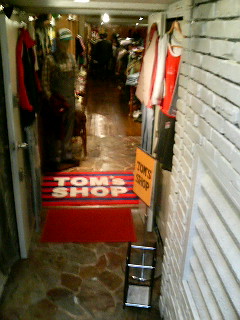 Tom's Shop: 渋谷区神宮前1-12-16和光ビルBF.
Tom's Shop: 渋谷区神宮前1-12-16和光ビルBF.Basement floor Wakkou Building, Jinguumae, Shibuya Ward.
Phone: (03) 5456 0236.
This place used to be on the 5th floor of the 和光 building, but as of late March 2006, could be found on the more accessible basement floor. It is similar to the E-Z shoes & clothes outlet up on the 2nd floor, although the shoes are cheaper (under 5000 Yen as far as I could see.) Apart from that, there is the usual selection of vintage wear, at pretty good prices.
Open 12noon to 9pm. Across the road from ABC Mart.
We Go: 渋谷区神宮前6-5-3ビル1-2F.
Iberia Biru 1F & 2F, 6-5-3 Jingumae, Shibuya, Tokyo.
Phone: (03) 3400 7625.
Variety vintage. T-shirts, jeans, shirts, hats, coats, you name it. Large chain with stores all over Japan. Open 10am to 9pm.
Saturday, May 11, 2013
Cafe Vuon Kieng in Ho Chi Minh City
Cafe Vườn Kiểng is one of my favorite cafes/bars in Ho Chi Minh City, although it is kind of tedious to reach (if you come on foot, be prepared to dodge the trucks crossing the road here, Tôn Đức Thắng Street almost exactly opposite Mê Linh Square with its statue of General Trần Hưng Đạo). If you make it here alive, however, you might be tempted to stay here for the rest of the day. The cafe sits right on the banks of the Saigon River, and boasts relaxing views and plenty of refreshing breezes. On the brown waters of the river an endless procession of craft passes, usually sluggishly: there are container ships, barges carrying garbage or tonnes of soil, junks bound to the Mekong Delta or filled to the brim with diners, and ferries, many ferries, some of them designed like monsters. Opposite the cafe lies all green and tropical the Thủ Thiêm island, which survives as a bastion of rural Vietnam in the heart of the city. Remarkably, as of 2010 when I was there last there was no bridge linking Thủ Thiêm with downtown, so traffic had to queue cattlestyle before being ferried across the river. Two ferries seemed to work on the job all day long, and I never grew tired of watching them crisscrossing from jetty to jetty, loaded down with their motorbikes and cars. I just love watching people work when I am on holiday!
If you ever look out the window of your plane coming in to land, you will see Ho Chi Minh City is lashed by any number of languidly lolling rivers. These rivers are the lifeblood of the city's trade, but they have also curtailed its development and limited its potential. Thủ Thiêm has been isolated until now (hence its charm), but there are big plans for its future. Check out the island's official homepage for a glimpse of what could be in store. If Thủ Thiêm does indeed become a new metropolis, then Cafe Vườn Kiểng would be ideally situated as a waystation on a hot, humid day. You could park your motorbike in the lot out the front, go in and sink a cold beer on the deck.
 |
| Cafe Vuon Kieng, on Ton Duc Thang Street, in Ho Chi Minh City (Vietnam, 2010) |
If you ever look out the window of your plane coming in to land, you will see Ho Chi Minh City is lashed by any number of languidly lolling rivers. These rivers are the lifeblood of the city's trade, but they have also curtailed its development and limited its potential. Thủ Thiêm has been isolated until now (hence its charm), but there are big plans for its future. Check out the island's official homepage for a glimpse of what could be in store. If Thủ Thiêm does indeed become a new metropolis, then Cafe Vườn Kiểng would be ideally situated as a waystation on a hot, humid day. You could park your motorbike in the lot out the front, go in and sink a cold beer on the deck.
 |
| Watching the world slide by at Cafe Vuon Kieng, on Saigon River (Vietnam, 2010) |
Cafe Vườn Kiểng: 10B Tôn Đức Thắng St, Dist. 1, Ho Chi Minh City, Vietnam. Phone: (08) 290 9410.
Banh Xeo in Ho Chi Minh City
I am not normally fond of meals wrapped in pastry (unless they happen to be highly meat & cheese specific, the ultimate being the famed burrito of Amexico, or the mighty kebap of the Trung-dong, or the Dong-trung, or however they call the Middle-East in Vietnamese!) When it comes to largely vegetable or roots & shoots spreads wrapped in pastry I am afraid you are going to have to count me out, as John Lennon once asserted, defiantly. It doesn't look good, it doesn't crunch good, and I am not exactly sure why. Maybe I had the odd bad experience with monjayaki in Japan, or a soggy okonomiyaki in some park somewhere beneath the cherry blossoms. My mother always used to make me soggy sandwiches with prefreezed thawed out on the kitchen sink in the morning sun white bread when I was at school, in hicksville Australia. The slices of bread would still be icy while she was buttering them up, coating them with Vegemite. However, no need to fear bad cooking here -- the Vietnamese have a knack for kicking life into the types of food which often taste bland in other countries (Vietnam style rice porridge being a prime example). So, bánh xèo may yet surprise me. Many claim it is the best food to be found in southern Vietnam, and its popularity has spread to other parts of the world. For the uninitiated, bánh xèo (literally "cake sizzling") are Vietnamese crepes stuffed with pork, shrimp, and bean sprouts. If the photos on the Internet are anything to go by, the bean sprouts sure do outnumber the bodies of shrimps of the pieces of pork, and that is what concerns me. I am disturbed by the thought of biting through pastry to discover limp vegetable matter, soggy waterlogged vegetable pastry mush... that makes me want to barf. To intensify the greens factor, bánh xèo are wrapped in vegetable leaves... for example, mustard leaf, lettuce leaves, etc. Wrapping food in leaves and then plonking the finished product into a dipping sauce is a big tradition in Vietnam...
Why do they give bánh xèo the fiery, explosive name that they do? Noodlepie the lonely food nerd and conqueror of Indochina says: "While the recipe itself might be a piece of piss, getting it right requires a deft hand, a frying pan as hot as the sun and a nibble touch with the batter." As if to echo my aforementioned sogginess fears, Noodlepie carries on: "Bánh xèo pancakes should be crispy on the outside and ever so slightly moist on the inside. Leaving it hanging around too long and you've got a soggy savoury crepe on your hands and you don't want that, believe me..."
I have watched a few videos of bánh xèo being cooked, and it seems the secret to its explosive crispiness lies in the way the chef swiftly swirls the batter around the hot wok. In the photo above you can see a bánh xèo chef at work on his wok, halfway through the swirl. That's how they do it, Saigon street style. In the video below, you can see how the pro's do it at home.
 |
| Chefs sizzling at their wo(r)k, in Ho Chi Minh City (Vietnam, 2010) |
Why do they give bánh xèo the fiery, explosive name that they do? Noodlepie the lonely food nerd and conqueror of Indochina says: "While the recipe itself might be a piece of piss, getting it right requires a deft hand, a frying pan as hot as the sun and a nibble touch with the batter." As if to echo my aforementioned sogginess fears, Noodlepie carries on: "Bánh xèo pancakes should be crispy on the outside and ever so slightly moist on the inside. Leaving it hanging around too long and you've got a soggy savoury crepe on your hands and you don't want that, believe me..."
I have watched a few videos of bánh xèo being cooked, and it seems the secret to its explosive crispiness lies in the way the chef swiftly swirls the batter around the hot wok. In the photo above you can see a bánh xèo chef at work on his wok, halfway through the swirl. That's how they do it, Saigon street style. In the video below, you can see how the pro's do it at home.
Not Quite Banh Goi, But in the Same Ballpark
To my western eye, they look like Indian samosas. Others have compared them with Cornish pasties. Noodlepie, that connoisseur of Vietnamese street food, says: "You can find this anytime-of-day snack all over town. Mine came served in an ingenious little snack pocket made of crumpled up magazine advertisement pages with a bag of sweet chili dipping sauce. They cost around 5,000VD a throw (US$1 = 15,700VD). The centre is filled with lightly spiced minced pork and onions. The pastry is fried to a thin crisp giving a satisfying crunchy-munch."
The thing in the photo above is not Bánh gối. I don't know what it is called, but maybe it is on the Bánh gối bent. It is in the same basic ballpark, to my western taste buds at least. I bought it from a bread shop across the road from the Cultural Park, near a proper Bánh gối streetstall, the second last time I was in Vietnam, mid 2010. Pikelet and Pie says: "Bánh gối, or pillow cakes, seem to be the curry-less curry puff of Vietnamese cuisine. Deep fried pastry perfection encasing a texturally diverse jumble of glass noodles, minced pork, wood ear mushrooms and thin slices of lap cheong. Crisp, flaky exteriors, flavourful fillings. Dip them in the your self-adjusted sauce and alternate mouthfuls with cold vermicelli noodles and plentiful fresh herbs..."
 |
| Not quite Banh goi, but in the same basic ballpark (Vietnam, 2010) |
The thing in the photo above is not Bánh gối. I don't know what it is called, but maybe it is on the Bánh gối bent. It is in the same basic ballpark, to my western taste buds at least. I bought it from a bread shop across the road from the Cultural Park, near a proper Bánh gối streetstall, the second last time I was in Vietnam, mid 2010. Pikelet and Pie says: "Bánh gối, or pillow cakes, seem to be the curry-less curry puff of Vietnamese cuisine. Deep fried pastry perfection encasing a texturally diverse jumble of glass noodles, minced pork, wood ear mushrooms and thin slices of lap cheong. Crisp, flaky exteriors, flavourful fillings. Dip them in the your self-adjusted sauce and alternate mouthfuls with cold vermicelli noodles and plentiful fresh herbs..."
Thursday, March 21, 2013
Floating Worlds
Sick of hanging round the house, I rose early and rode Busways #90 (ticket: AUS$4.60) over to Budgewoi, on the opposite side of the lake. The cops were arresting some dude at the interchange at Lake Haven while I was waiting for my bus... typical. There was a big mob of single mums and truant teens congregated round the commotion, rubbernecking, teeheeing, bumming cigarettes... standard. It seemed like it was going to be a warm day, which is usual in this part of the world, at this time of the year. Once the bus pulled up, however, it was all air-con chilled and comfy, if somewhat claustrophobic. Pushing through the scrum, I climbed the step, paid the driver, and took my favorite seat behind the midriff exit, the one fronted with its own perspex shield. Maybe it is because it is shielded that I like it so much, it seems to offer some protection against something, I don't know what. I pulled out my iPhone and was checking the news when I noticed my old Salvation Army mate Simon stepping up on to the transport, so I gestured him over to sit with me. He obliged me cheerfully, the bus took off, and we were on our way through the dewy, sun-sparkled, spider silk-strewn streets. A little bit later, on the approach to Toukley Bridge, my drinking partner Steve boarded, and took a seat in front of me. I am not sure if he recognized me or not, but I certainly recognized him. I am starting to build up a network of Negroes up here in the Wyong Shire, 18 months after moving here, I am getting to know the scene pretty well. People wave to me when I walk the streets, they beep their horns as they drive past me. It makes me think I have been here too long, and that it is probably time to roll the dice again, and jump to a new locale. Do another Quantum Leap, and materialize into a brand new life. I have still got a year to go before the jump, but the coordinates are already being plotted, the warpdrive readied for action! Soon I will be on my merry way, winging myself to a whole different city/country/civilization, and Australia will be just a memory (again.) Anyway, I had a bit of a chat to Simon before he got off, and told him some yarns from my time in Japan in exchange for a bit of his life story. He seems like a drifter to me, a natural nomad: originally from Leichhardt in Sydney, he now works at the supermarket at Lake Haven, and is looking for a decent place to live in the vicinity. He complained about all the hoops you need to jump through to make it with the landlords these days, the character references required by real estate agents, the proof that you have a job, etc. Listening to Simon talk, I felt my resentment rise. Why do they make it so hard for nomads like us? I wondered. What's up with all this Nanny State nonsense? It's discrimination, that's what it is! discrimination against those who don't fit the regular profile! Discrimination, in other words, against people like me. Simon bundled out once we hit Toukley to attend his interview with the real estate agents, and Steve disembarked shortly afterwards. I was all on my own in my fave seat as the bus lumbered on, through the backstreets of Norahville, taking me on a nostalgia trip of my early adulthood (I used to work at the newspaper here in 1994/95). Ahead of me, blonde-haired women were sharing tips on how to rort the Housing Department, while their blonde kids ran amok up and down the aisle. It is a very blond(e) blue-eyed part of the world here, and kind of a fascistic one... a welfare fascist state, if such a thing is possible. A whole lost tribe of Britons grown up feral among the gum trees and rainbow lorikeets, DNA bleached by the relentless sun. Flotsam and jetsam of a vanished Empire, washed up on to the Antipodean shore. Quite a few people up here are on the dole, myself included. Public transport in Australia seems reserved for folks like us. This is not Japan, where CEOs are humble enough to catch the train to work. Here in Oz humility is not a virtue anymore, and the CEOs probably get around town by helicopter. We turned on to Budgewoi Road and motored along past holiday homes, caravan parks, and even the odd golf course. Fibro shacks presently yielded on the right to a long, scrub-lined beach. This was Lakes Beach, in fact, and my mission for the day was to follow it homeward, back to Norah Head, where Wallarah Road would pick me up and carry me through Toukley to the Wallarah Bay Recreation Club. Where hopefully my Dad and a couple of beers were waiting! While in the area I also wanted to have a peek at Lake Munmorah, which the satellite pics claim is up here. I like to get a mental map of the geography, wherever I am living; I like to know my way around on foot, just in case I get lost and can't find my way back home.
The satellites were right... Lake Munmorah was up here, and I found it easily enough, near the sleepy retail heart of Budgewoi. The lake was smaller than I imagined, and its shores less developed than its companions up here, such as my mistress (Budgewoi Lake). Seaweed padded the bank like a rotting carpet, encasing within in it fallen tree trunks and pieces of driftwood washed up from God only knows where, the occasional strewn bottle of beer or crumpled aluminum can, packed full of mud. The coastal plain from Tuggerah to Newcastle is riddled with lakes like this one, perforated with them, and I have often wondered how they formed. My Mum reckons they all started as bays: the western foreshores of the lakes were once beaches on the open sea, augmented by headlands and river mouths, and all the other usual Australian coastal features. Over time the bays clogged up with run-off from the rivers, and sand bars surfaced offshore, eventually linking up to create shallow lagoons within their perimeter. Having colonized the sea, land was in turn colonized by life, and the sand bars were overlaid with spear grasses, shrubs, trees, possibly even a littoral rainforest or two. Animals moved in to consume the plants or those animals which fed on them: birds, marsupials, fruit bats, frogs. Invasions washed over the region like high tides on a sandy beach, like tsunami. Four waves of human conquest followed, the last of them the Anglo-Saxon wave, settlers lured by the promise of prawns and outdoor sports, cheap housing just a few hours from the suburban sprawl of Sydney. That's the whitefella history of this region, the local Darkinyung Aboriginal people doubtless have their own creation story. Since the whitefellas won, their version became history. And so it will remain, until the whitefella settlement is itself submerged, and thrown back to the bottom of the sea. I'd say it will happen sometime before 2200, courtesy of Global Warming! Thus we have been warned; thus we will be warmed.
From the lake it wasn't that far to Lakes Beach, through an arm of somnolent suburbia. I strode past Halekulani Bowling Club with its attendant courtesy buses, crossed the channel which connects Lake Munmorah and Budgewoi Lake. Budgewoi actually means "meeting of the two waters" in the local Aboriginal language, and I wouldn't be surprised if the name sprang from this very channel, the one I was lucky to cross today. I continued over the Central Coast Highway, its asphalt surface burning hot in the sun. Waves could be heard crashing reassuringly not too distant, and there was a soothing salt smell in the air. I looked forward to being able to walk along the beach, and feel warm, soft sand between my toes. But the ocean also provokes in me a fear which is close to primal, so I was a little apprehensive about getting close to it. When I walk along the coast it feels like I am literally on the edge of the Earth, and I worry about falling off. Kind of irrational, but that is how it feels. Perhaps it is a symptom of agoraphobia.
One thing I noticed during a previous trek up here is how dramatically the vegetation changes the closer you get to the sea, plant leaves growing waxy, forests giving way to heaths and meadows where grevilleas flower in their sclerophyllus pods, and tiny blue wrens flit between the grasses, twitching like cicadas. Many people might think that the Australian landscape looks the same wherever you go but once you get to know it, and let go of your preconceptions, you will see that it actually comprises a cacophony of tiny habitats, each with their own inhabitants, noisy miners for the open spaces for example, more mysterious birds for the thicker bush. There are kingdoms built on top of kingdoms on top of kingdoms, realms on top of realms on top of realms. If you know how to read it, there is a story to be learnt here. In a burst of creativity Divinity beget the elemental realm from which emerged, from Sheer Nothing, the stars and planets, the galaxies and black holes, time and space itself. Stars burnt for billions of years, then burst into fiery supernovas, generating the heavy elements in their death throes. On rocky worlds orbiting second generation stars such as our own these elements aggregated, giving birth to the mineral kingdom, sandy beaches and mountains, volcanoes and tectonic plates, wide oceans shimmering beneath their local suns. Amazing enough, but greater glories were to come, on the planets lucky enough to be in the right place, with all the right conditions (the Goldilocks Zone): from the dexterity of carbon molecules began to order themselves, spontaneously, into life. Thus arose the vegetable kingdom, the animal kingdom, the fiefdom of the fungi... and finally the most audacious creation of all, the House of Humanity, Self-Awareness manifested directly into flesh...
As I traversed the sand drifts and scrub which bordered the ocean, I realized that the hot sun was making me thirsty. I looked out wistfully for a vending machine, but I knew I would never find one, not out here. I was on the edge of civilization, the interface of the cultivated world and the primeval nature from which it sprang. Even if there was a vending machine out here, it probably wouldn't work. This was not Japan, where green tea reprieves await you at every bend in the road, even way out in the wilds, near the summit of Mt Fuji. No, this was not Japan at all. I cut through the scrub, where volunteers had toiled to restore natural vegetation to the Pacific shore, and located some kind of path. The path (named Michael's Walk) led me to a boardwalk which floated over a patch of dry swamp. At the end of the boardwalk I found a sign describing the dune restoration project, dedicated lovingly to the memory of Julie Luff, a local resident and dunecarer.
Just a few steps on, the ocean now in sight, I was stopped in my tracks by a crucifix hanging from a paperbark tree. The crucifix was emblazoned with the mysterious name, "Shane", and accompanied by a bouquet of wilted flowers. I stood mesmerized before this makeshift shrine for a moment or two, wondering who Shane was, and what had happened to him here. Was it an accident, suicide, or death by drowning? His spirit might well still be hanging around here, haunting this sun-scorched coast.
Michael's Walk, the dedication to Julie Luff, and now Shane's tree, I thought. It seems like every square inch of land here is named after someone!
Everyone tries to leave their stamp on things, something to signify that they had been here. Dogs piss on trees, and monarchs brand their heads on to their stamps and coins. Patting the bulge in my pocket as I made my way down to the beach, I pondered: Why are the coins so heavy in Australia, so clunky, so chunky? I would like living here more if the coins were more practical. A pedantic thought, perhaps, but I believe there is symbolism in everything, even especially in the currency, in the currency that a country chooses to use. What does the Australian 50 cent coin tell you about this country, anyway: that we are clumsy people, that we're ruled by a foreign Queen? The huge coins are like the huge pills the pharmacists expect you swallow... they are not user-friendly. Not like the pills or the coins in Japan.
I took off my thongs and tumbled down to the beach, ready to commence my long walk to Norah Head. My eyes running along the shore, I tried to imagine what it would like flying over this coast in a passenger jet, headlands falling away beneath me, sandstone glinting in the sun, coal ships queued up on the approach to Newcastle, that great port to the near north. A jolt of electricity passed down my frame, adrenaline squirting up my arms, towards my hands. It was too much to think about, even to simulate it. My phobia was too strong. Mild despair gripped me, and a sinking feeling... when was I ever going to get off this rock? I remembered a month or so earlier, during an anxiety attack, I had been afraid to even look at the stars in the night sky, due to the overpowering sense of dread they engendered. To gaze upon the face of that naked immensity, that colossal emptiness, is truly a frightening thing... an entire Universe twinkling in the sky above, all those stars and floating worlds, stretching away remotely, but yet bearing their presence forcefully upon yours. That's the thing living in Australia, you see a lot of stars at night. You are dreadfully exposed. Beneath our feet, things are no less comforting. What really goes on down there, anyway?
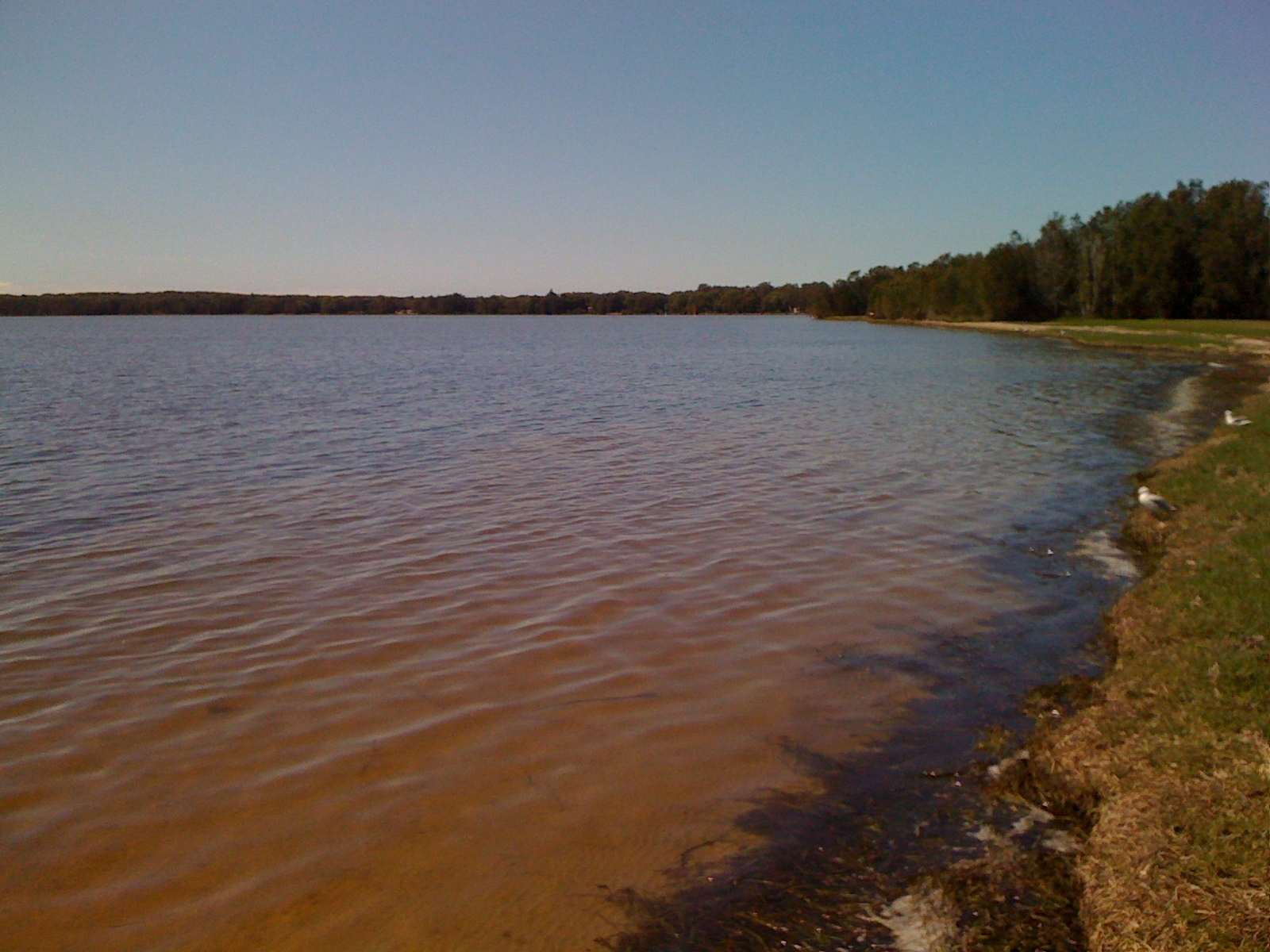 |
| Lake Munmorah, looking north and somewhat east, towards Newcastle (Australia, 2013) |
From the lake it wasn't that far to Lakes Beach, through an arm of somnolent suburbia. I strode past Halekulani Bowling Club with its attendant courtesy buses, crossed the channel which connects Lake Munmorah and Budgewoi Lake. Budgewoi actually means "meeting of the two waters" in the local Aboriginal language, and I wouldn't be surprised if the name sprang from this very channel, the one I was lucky to cross today. I continued over the Central Coast Highway, its asphalt surface burning hot in the sun. Waves could be heard crashing reassuringly not too distant, and there was a soothing salt smell in the air. I looked forward to being able to walk along the beach, and feel warm, soft sand between my toes. But the ocean also provokes in me a fear which is close to primal, so I was a little apprehensive about getting close to it. When I walk along the coast it feels like I am literally on the edge of the Earth, and I worry about falling off. Kind of irrational, but that is how it feels. Perhaps it is a symptom of agoraphobia.
 |
| Michael's Walk floats across this meadow, on the Budgewoi Beach Circuit (Australia, 2013) |
As I traversed the sand drifts and scrub which bordered the ocean, I realized that the hot sun was making me thirsty. I looked out wistfully for a vending machine, but I knew I would never find one, not out here. I was on the edge of civilization, the interface of the cultivated world and the primeval nature from which it sprang. Even if there was a vending machine out here, it probably wouldn't work. This was not Japan, where green tea reprieves await you at every bend in the road, even way out in the wilds, near the summit of Mt Fuji. No, this was not Japan at all. I cut through the scrub, where volunteers had toiled to restore natural vegetation to the Pacific shore, and located some kind of path. The path (named Michael's Walk) led me to a boardwalk which floated over a patch of dry swamp. At the end of the boardwalk I found a sign describing the dune restoration project, dedicated lovingly to the memory of Julie Luff, a local resident and dunecarer.
 |
| In memory of Julie Luff, a map of the Budgewoi Beach Circuit Walk (Australia, 2013) |
Michael's Walk, the dedication to Julie Luff, and now Shane's tree, I thought. It seems like every square inch of land here is named after someone!
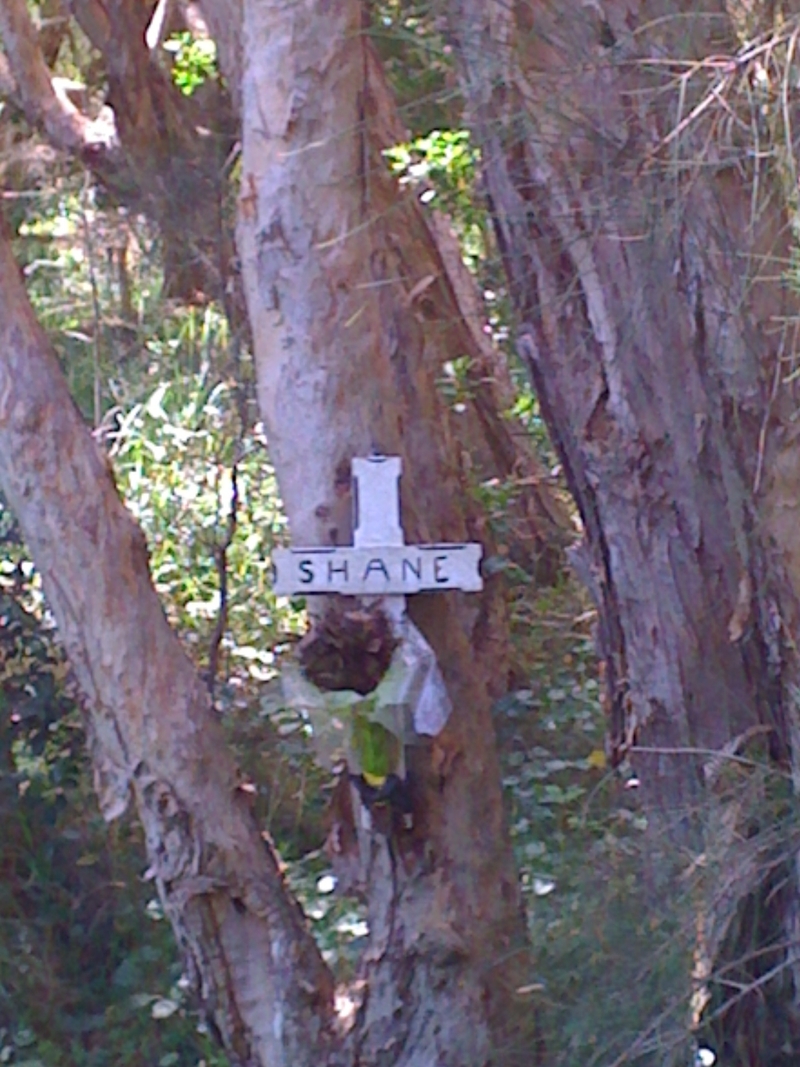 |
| Memorial to a guy named Shane (Australia, 2013) |
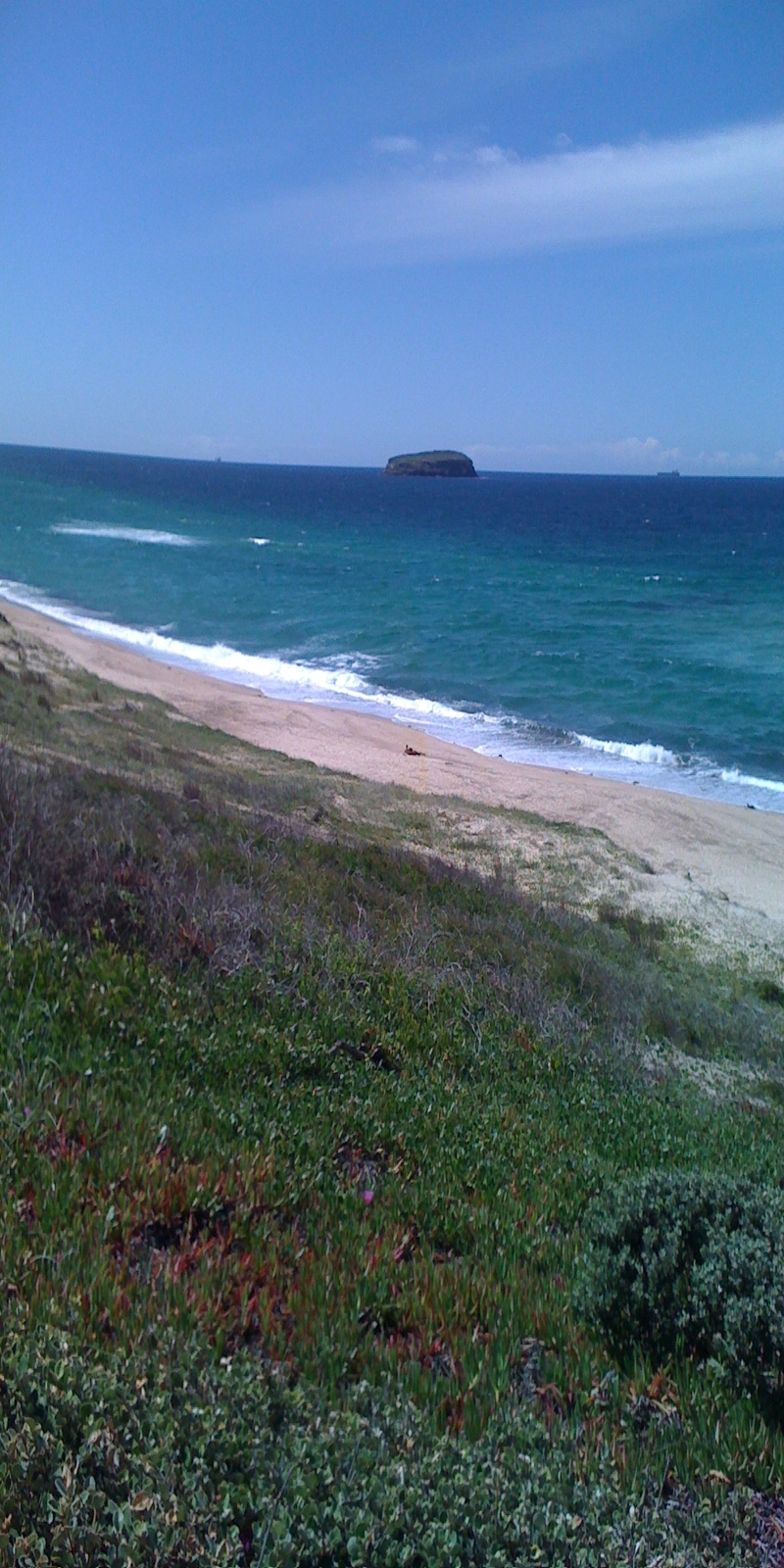 |
| Bird Island, off the Lakes Beach, in Wyong Shire, NSW (Australia, 2013) |
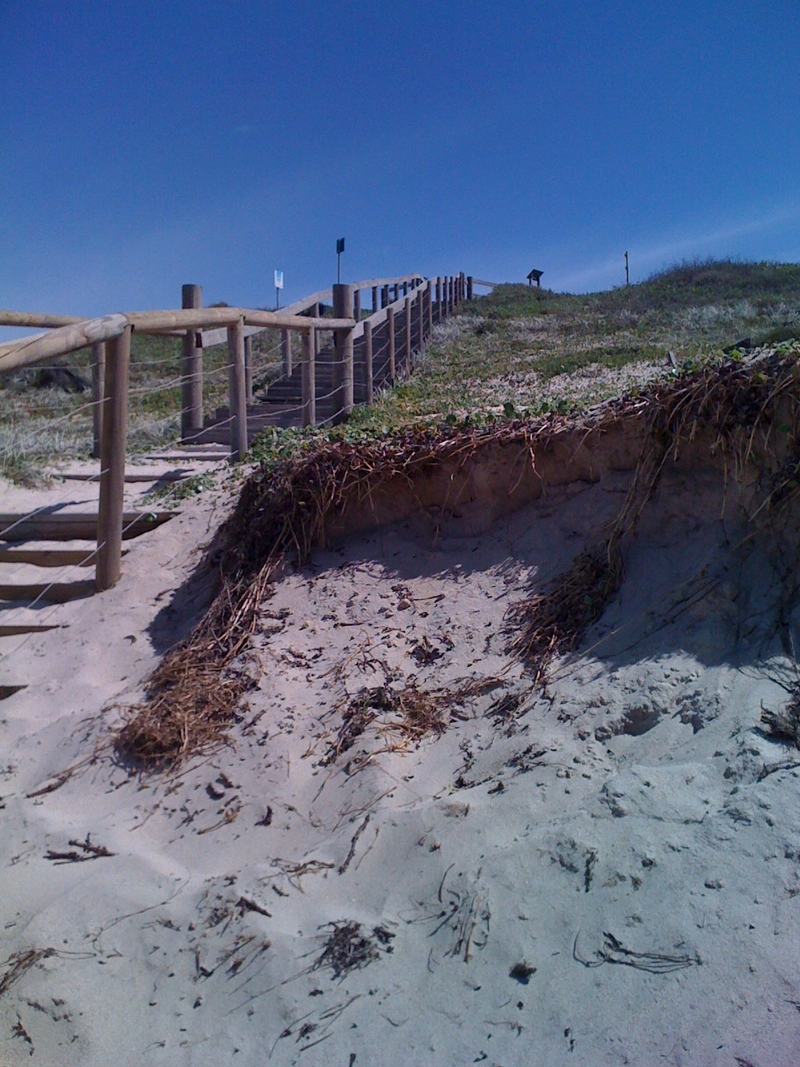 |
| Tumbling down the stairs on to the warm sands of Lakes Beach, near Budgewoi (Australia, 2013) |
Sometimes these days it feels as if I am living in a floating world, cast adrift on a rising tide. The ground beneath my feet seems solid enough, but I know that the whole continent is riding like a raft on a magma sea, creeping north, irrepressibly. Above me the sky, that infernally cheerful blue sky... what could be more steadfast than that sky you might think, what could be more dependable? But like the ground, the blue sky is a deception, a lie... you could even call it a mirage. The sun is not yellow at all, it is white, and the blueness of the sky is merely an effect, caused by the scattering of the solar radiation through the atmosphere. As Einstein boldly proclaimed, we are all trapped in our own little bubbles of relativity only rarely encountering all the other floating bubbles out there, like ships passing in the night. Rare is the man or woman intuitive enough to notice when the bubbles bounce against each other in a momentary collision, soft film walls yielding ever so slightly. Rarer still is the man or woman who can pierce the film which separates our floating worlds in a resounding pop!, and dive through the mirror from one universe into another, merging with it, breathing underwater.







